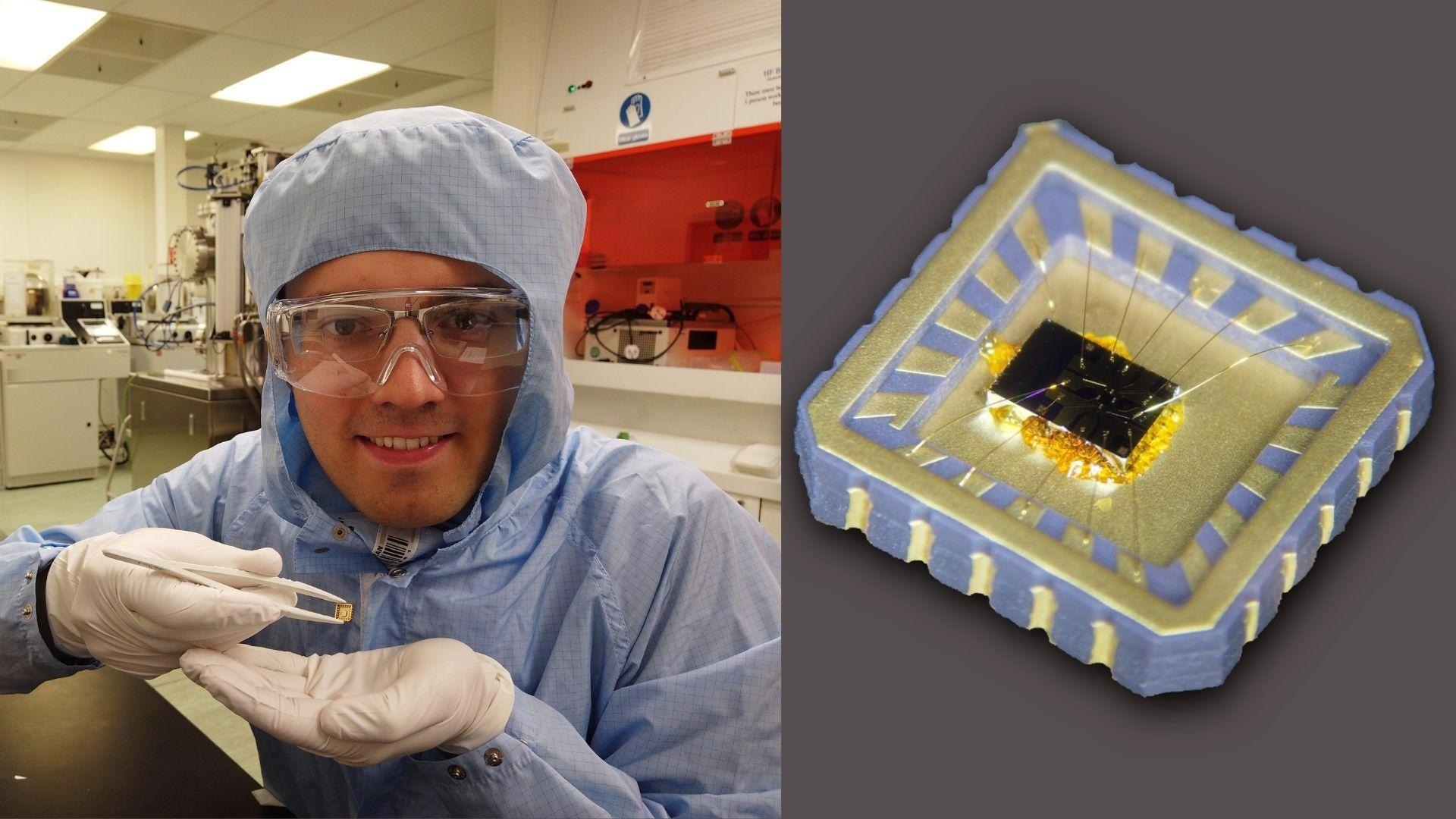A group of researchers from the Cavendish Laboratory, along with their co-workers at the Universities of Augsburg (Germany) and Lancaster, has discovered a novel physical effect when two-dimensional electron systems are subjected to terahertz waves.
 Wladislaw Michailow showing device in the cleanroom and A terahertz detector after fabrication. Image Credit: Wladislaw Michailow.
Wladislaw Michailow showing device in the cleanroom and A terahertz detector after fabrication. Image Credit: Wladislaw Michailow.
Professor David Ritchie explains what exactly terahertz waves are.
We communicate using mobile phones that transmit microwave radiation and use infrared cameras for night vision. Terahertz is the type of electromagnetic radiation that lies in-between microwave and infrared radiation, but at the moment, there is a lack of sources and detectors of this type of radiation, that would be cheap, efficient, and easy to use. This hinders the widespread use of terahertz technology.
David Ritchie, Professor and Head, Semiconductor Physics Group, Cavendish Laboratory, University of Cambridge
In 2002, investigators from the Semiconductor Physics group, in collaboration with researchers from Pisa and Torino in Italy, were the first to illustrate the operation of a quantum cascade laser at terahertz frequencies. Ever since, the team has continued to examine and develop functional terahertz devices that incorporate metamaterials as modulators, and also new types of detectors.
Suppose the lack of usable devices was solved. In that case, terahertz radiation could find application in security, materials science, communications, and medicine. Terahertz waves, for example, can be used to image cancerous tissue that is not visible to the naked eye.
They can be used in the new generation of fast and safe airport scanners that can distinguish medicines from illegal drugs and explosives, as well as facilitate even faster wireless communications than presently available.
Dr. Wladislaw Michailow details what exactly this discovery is.
We were developing a new type of terahertz detector, but when measuring its performance, it turned out that it showed a much stronger signal than should be theoretically expected. So we came up with a new explanation.
Dr. Wladislaw Michailow, Study First Author and Junior Research Fellow, Trinity College Cambridge
According to the researchers, the explanation lies in the way light interacts with matter. Matter takes up light in the form of single particles called photons at high frequencies. Einstein postulated this interpretation, which became the foundation of quantum mechanics and explained the photoelectric effect.
This quantum photoexcitation is how cameras in smartphones detect light, and it is also how solar cells produce electricity from light.
The well-known photoelectric effect involves incident photons releasing electrons from a conductive material—metal or a semiconductor. In the three-dimensional case, photons in the ultraviolet or X-Ray range can expel electrons into a vacuum, or they can be released into a dielectric in the mid-infrared to the visible range. The finding of a quantum photoexcitation method in the terahertz range that is nearly identical to the photoelectric effect is the novelty.
The fact that such effects can exist within highly conductive, two-dimensional electron gases at much lower frequencies has not been understood so far, but we have been able to prove this experimentally.
Dr. Wladislaw Michailow, Study First Author and Junior Research Fellow, Trinity College Cambridge
A co-worker from the University of Augsburg in Germany created the quantitative theory of the effect, and the research team published their observations in the prestigious journal Science Advances.
The phenomenon was named “in-plane photoelectric effect” by the investigators. The researchers describe several advantages of using this effect for terahertz detection in the corresponding paper. The magnitude of the photoresponse produced by incident terahertz radiation by the “in-plane photoelectric effect” is much greater than anticipated from other mechanisms previously known to generate a terahertz photoresponse.
As a result, the researchers believe that this effect will allow for the construction of terahertz detectors with significantly higher sensitivity.
Prof Ritchie states, “This brings us one step closer to making terahertz technology usable in the real world.”
The study was funded by the EPSRC projects HyperTerahertz (no. EP/P021859/1) and grant no. EP/S019383/1, the Schiff Foundation of the University of Cambridge, Trinity College Cambridge, and the European Union’s Horizon 2020 research and innovation program Graphene Core 3 (grant no. 881603).
Journal Reference:
Michailow, W., et al. (2022) An in-plane photoelectric effect in two-dimensional electron systems for terahertz detection. Science Advances. doi.org/10.1126/sciadv.abi8398.